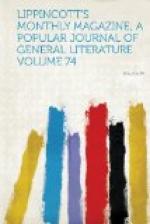At seven or eight miles’ distance another streamlet was reached, named the Mamabamba. It is a slender affluent of the Cconi, to be called a rivulet in any country but South America, but here named a river with the same proud effrontery which designates as a city any collection of a dozen huts thrown into the ravine of a mountain. The Mamabamba was crossed by an extemporized bridge, constructed on the spot by the ingenuity of Garcia and his men. Strange and incalculable was the engineering of Pepe Garcia. Sometimes, across one of these continually-occurring streams, he would throw a hastily-felled tree, over which, glazed as it was by a night’s rain or by the humidity of the forest, he would invite the travelers to pass. Sometimes, to a couple of logs rotting on the banks he would nail cross-strips like the rungs of a ladder, and, while the torrent boiled at a distance below, pass jauntily with his Indians, more sure-footed than goats. The wider the abyss the more insecure the causeway; and the terrible rope-bridges of South America, or the still more conjectural throw of a line of woven roots, would meet the travelers wherever the cleft was so wide as to render timbering an inconvenient trouble. Occasionally, on one of these damp and moss-grown ladders, a peon’s foot would slip, and down he would go, the load strapped on his back catching him as he was passing through the aperture: then, using his hands to hold on by, he would compose, on the spur of the moment, a new and original language or telegraphy of the legs, kicking for assistance with all his might. Juan of Aragon was usually the hero to extricate these poor estrays from the false step they had taken, the other peons regarding the scene with their tranquil stolidity. A glass of brandy to the unfortunate would always compose his nerves again, and make him hope for a few more accidents of a like nature and bringing a like consolation.
[Illustration: “THE MAMABAMBA WAS CROSSED BY AN EXTEMPORIZED BRIDGE.”]
The bridge of the Mamabamba conducted the party to a site of the same name, through an interval of forest where might be counted most of the varieties of tree proper to the equatorial highlands. Up to this point the vegetation everywhere abounding had not indicated the presence, or even the vicinage, of the cinchona. The only circumstance which brought it to the notice of the inexperienced leaders of the expedition would be a halt made from time to time by the Bolivian bark-hunters. The examinador and his cascarilleros, touching one tree or another with their hatchets, would exchange remarks full of meaning and mysteriousness; but when the colonel or Mr. Marcoy came to ask the significance of so many hints and signals, they got the invariable answer of Sister Anna to the wife of Bluebeard: “I see nothing but the forest turning green and the sun turning red.” The most practical reminder of the quest of cinchona which the travelers found




